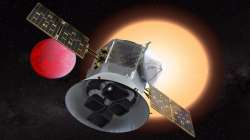NASA's next planet-hunter, the Transiting Exoplanet Survey Satellite (Tess) successfully launched on a SpaceX Falcon 9 rocket from Cape Canaveral Air Force Station in Florida.
The satellite launched at 6.51 p.m. EDT on Wednesday (4.21 a.m. on Thursday, India time).
Tess, which is expected to find thousands of new exoplanets orbiting nearby stars, including some that could support life, was earlier scheduled to launch on Monday (4.02 a.m. on Tuesday, India time) but was rescheduled to conduct further Guidance, Navigation and Control analysis, NASA said.
"We are thrilled Tess is on its way to help us discover worlds we have yet to imagine, worlds that could possibly be habitable, or harbour life," said Thomas Zurbuchen, Associate Administrator of NASA's Science Mission Directorate in Washington.
Over the course of several weeks, Tess will use six thruster burns to travel in a series of progressively elongated orbits to reach the Moon, which will provide a gravitational assist so that the spacecraft can transfer into its 13.7-day final science orbit around Earth, NASA said.
After approximately 60 days of check-out and instrument testing, the spacecraft will begin its work, the US space agency added.
Tess will spend about two years surveying 200,000 of the brightest stars near the Sun to search for planets outside our solar system.
For this two-year survey mission, scientists divided the sky into 26 sectors.
The spacecraft will use four unique wide-field cameras to map 13 sectors encompassing the southern sky during its first year of observations and 13 sectors of the northern sky during the second year, altogether covering 85 per cent of the sky.
Tess will be watching for phenomena called transits. A transit occurs when a planet passes in front of its star from the observer's perspective, causing a periodic and regular dip in the star's brightness.
More than 78 per cent of the approximately 3,700 confirmed exoplanets have been found using transits.
NASA's Kepler spacecraft found more than 2,600 exoplanets, most orbiting faint stars between 300 and 3,000 light-years from Earth, using this same method of watching for transits.
The new planet-hunter will focus on stars between 30 and 300 light-years away and 30 to 100 times brighter than Kepler's targets, NASA said.
The brightness of these target stars will allow researchers to use spectroscopy, the study of the absorption and emission of light, to determine a planet's mass, density and atmospheric composition.
Water, and other key molecules, in its atmosphere can give us hints about a planet's capacity to harbour life.
"The targets Tess finds are going to be fantastic subjects for research for decades to come," said Stephen Rinehart, Tess project scientist at NASA's Goddard Space Flight Center in Greenbelt, Maryland.
"It's the beginning of a new era of exoplanet research," Rinehart added.

